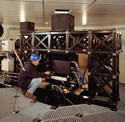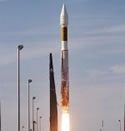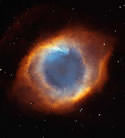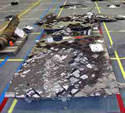People with clear skies Thursday night were treated to a total lunar eclipse. The eclipse began at 0203 (10:03pm EDT) and ended approximately three hours later. The weather wasn?t entirely cooperating; however, many astrocameras poised around North America and Europe ended up being rained out. The next lunar eclipse will be on November 9, 2003, and will be visible from roughly the same parts of the Earth ? only this time it?ll be brighter.
NASA Orders Prototype Martian Airplane
After a series of successful tests with a half-sized prototype, NASA has ordered a full-scale prototype of the Ares (Aerial Regional-scale Environmental Survey of Mars), aircraft, designed to help explore the surface of Mars. If all goes well, the aircraft will be launched to Mars in 2007. When it arrives in 2008, it will enter the atmosphere, deploy its wings and fly 850 kilometres along a route that takes it past the terrain that NASA scientists want to observe.
Lunar Eclipse Tonight
The Americas and part of Europe will be treated to a total eclipse of the moon on Thursday night ? the first one visible here in three years. A lunar eclipse occurs when the Earth?s shadow falls on the Moon, turning it a deep red colour. Unlike solar eclipses, lunar eclipses are completely safe to watch with the naked eye; and it looks even better with a pair of binoculars or small telescope. The eclipse begins at 0203 GMT Friday (10:03pm EDT Thursday), and reaches the maximum at 0340 GMT (11:40pm EDT). The eclipse will be best viewed from the Eastern Coast of the United States.
Paranal Observatory Tests New Adapative Optics

Image credit: ESO
A team of engineers from the European Southern Observatory recently tested out a new adaptive optics facility on the Very Large Telescope (VLT) at the Paranal Observatory in Chile. This technology adapts images taken by the telescope to remove the distortion caused by the Earth?s atmosphere ? as if they were seen from space. The next step will be to connect similar systems to all the telescopes at the facility and then hook them up in a large array. This should allow the observatory to resolve objects 100 times fainter than today.
On April 18, 2003, a team of engineers from ESO celebrated the successful accomplishment of “First Light” for the MACAO-VLTI Adaptive Optics facility on the Very Large Telescope (VLT) at the Paranal Observatory (Chile). This is the second Adaptive Optics (AO) system put into operation at this observatory, following the NACO facility (ESO PR 25/01).
The achievable image sharpness of a ground-based telescope is normally limited by the effect of atmospheric turbulence. However, with Adaptive Optics (AO) techniques, this major drawback can be overcome so that the telescope produces images that are as sharp as theoretically possible, i.e., as if they were taken from space.
The acronym “MACAO” stands for “Multi Application Curvature Adaptive Optics” which refers to the particular way optical corrections are made which “eliminate” the blurring effect of atmospheric turbulence.
The MACAO-VLTI facility was developed at ESO. It is a highly complex system of which four, one for each 8.2-m VLT Unit Telescope, will be installed below the telescopes (in the Coud? rooms). These systems correct the distortions of the light beams from the large telescopes (induced by the atmospheric turbulence) before they are directed towards the common focus at the VLT Interferometer (VLTI).
The installation of the four MACAO-VLTI units of which the first one is now in place, will amount to nothing less than a revolution in VLT interferometry. An enormous gain in efficiency will result, because of the associated 100-fold gain in sensitivity of the VLTI.
Put in simple words, with MACAO-VLTI it will become possible to observe celestial objects 100 times fainter than now. Soon the astronomers will be thus able to obtain interference fringes with the VLTI (ESO PR 23/01) of a large number of objects hitherto out of reach with this powerful observing technique, e.g. external galaxies. The ensuing high-resolution images and spectra will open entirely new perspectives in extragalactic research and also in the studies of many faint objects in our own galaxy, the Milky Way.
During the present period, the first of the four MACAO-VLTI facilties was installed, integrated and tested by means of a series of observations. For these tests, an infrared camera was specially developed which allowed a detailed evaluation of the performance. It also provided some first, spectacular views of various celestial objects, some of which are shown here.
MACAO – the Multi Application Curvature Adaptive Optics facility
Adaptive Optics (AO) systems work by means of a computer-controlled deformable mirror (DM) that counteracts the image distortion induced by atmospheric turbulence. It is based on real-time optical corrections computed from image data obtained by a “wavefront sensor” (a special camera) at very high speed, many hundreds of times each second.
The ESO Multi Application Curvature Adaptive Optics (MACAO) system uses a 60-element bimorph deformable mirror (DM) and a 60-element curvature wavefront sensor, with a “heartbeat” of 350 Hz (times per second). With this high spatial and temporal correcting power, MACAO is able to nearly restore the theoretically possible (“diffraction-limited”) image quality of an 8.2-m VLT Unit Telescope in the near-infrared region of the spectrum, at a wavelength of about 2 ?m. The resulting image resolution (sharpness) of the order of 60 milli-arcsec is an improvement by more than a factor of 10 as compared to standard seeing-limited observations. Without the benefit of the AO technique, such image sharpness could only be obtained if the telescope were placed above the Earth’s atmosphere.
The technical development of MACAO-VLTI in its present form was begun in 1999 and with project reviews at 6 months’ intervals, the project quickly reached cruising speed. The effective design is the result of a very fruitful collaboration between the AO department at ESO and European industry which contributed with the diligent fabrication of numerous high-tech components, including the bimorph DM with 60 actuators, a fast-reaction tip-tilt mount and many others. The assembly, tests and performance-tuning of this complex real-time system was assumed by ESO-Garching staff.
Installation at Paranal
The first crates of the 60+ cubic-meter shipment with MACAO components arrived at the Paranal Observatory on March 12, 2003. Shortly thereafter, ESO engineers and technicians began the painstaking assembly of this complex instrument, below the VLT 8.2-m KUEYEN telescope (formerly UT2).
They followed a carefully planned scheme, involving installation of the electronics, water cooling systems, mechanical and optical components. At the end, they performed the demanding optical alignment, delivering a fully assembled instrument one week before the planned first test observations. This extra week provided a very welcome and useful opportunity to perform a multitude of tests and calibrations in preparation of the actual observations.
AO to the service of Interferometry
The VLT Interferometer (VLTI) combines starlight captured by two or more 8.2- VLT Unit Telescopes (later also from four moveable1.8-m Auxiliary Telescopes) and allows to vastly increase the image resolution. The light beams from the telescopes are brought together “in phase” (coherently). Starting out at the primary mirrors, they undergo numerous reflections along their different paths over total distances of several hundred meters before they reach the interferometric Laboratory where they are combined to within a fraction of a wavelength, i.e., within nanometers!
The gain by the interferometric technique is enormous – combining the light beams from two telescopes separated by 100 metres allows observation of details which could otherwise only be resolved by a single telescope with a diameter of 100 metres. Sophisticated data reduction is necessary to interpret interferometric measurements and to deduce important physical parameters of the observed objects like the diameters of stars, etc., cf. ESO PR 22/02.
The VLTI measures the degree of coherence of the combined beams as expressed by the contrast of the observed interferometric fringe pattern. The higher the degree of coherence between the individual beams, the stronger is the measured signal. By removing wavefront aberrations introduced by atmospheric turbulence, the MACAO-VLTI systems enormously increase the efficiency of combining the individual telescope beams.
In the interferometric measurement process, the starlight must be injected into optical fibers which are extremely small in order to accomplish their function; only 6 ?m (0.006 mm) in diameter. Without the “refocussing” action of MACAO, only a tiny fraction of the starlight captured by the telescopes can be injected into the fibers and the VLTI would not be working at the peak of efficiency for which it has been designed.
MACAO-VLTI will now allow a gain of a factor 100 in the injected light flux – this will be tested in detail when two VLT Unit Telescopes, both equipped with MACAO-VLTI’s, work together. However, the very good performance actually achieved with the first system makes the engineers very confident that a gain of this order will indeed be reached. This ultimate test will be performed as soon as the second MACAO-VLTI system has been installed later this year.
MACAO-VLTI First Light
After one month of installation work and following tests by means of an artificial light source installed in the Nasmyth focus of KUEYEN, MACAO-VLTI had “First Light” on April 18 when it received “real” light from several astronomical obejcts.
During the preceding performance tests to measure the image improvement (sharpness, light energy concentration) in near-infrared spectral bands at 1.2, 1.6 and 2.2 ?m, MACAO-VLTI was checked by means of a custom-made Infrared Test Camera developed for this purpose by ESO. This intermediate test was required to ensure the proper functioning of MACAO before it is used to feed a corrected beam of light into the VLTI.
After only a few nights of testing and optimizing of the various functions and operational parameters, MACAO-VLTI was ready to be used for astronomical observations. The images below were taken under average seeing conditions and illustrate the improvement of the image quality when using MACAO-VLTI.
MACAO-VLTI – First Images
Here are some of the first images obtained with the test camera at the first MACAO-VLTI system, now installed at the 8.2-m VLT KUEYEN telescope.
PR Photos 12b-c/03 show the first image in the infrared K-band (wavelength 2.2 ?m) of a star (visual magnitude 10) obtained without and with image corrections by means of adaptive optics.
PR Photo 12d/03 displays one of the best images obtained with MACAO-VLTI during the early tests. It shows a Strehl ratio (measure of light concentration) that fulfills the specifications according to which MACAO-VLTI was built. This enormous improvement when using AO techniques is clearly demonstrated in PR Photo 12e/03, with the uncorrected image profile (left) hardly visible when compared to the corrected profile (right).
PR Photo 11f/03 demonstrates the correction capabilities of MACAO-VLTI when using a faint guide star. Tests using different spectral types showed that the limiting visual magnitude varies between 16 for early-type B-stars and about 18 for late-type M-stars.
Astronomical Objects seen at the Diffraction Limit
The following examples of MACAO-VLTI observations of two well-known astronomical objects were obtained in order to provisionally evaluate the research opportunities now opening with MACAO-VLTI. They may well be compared with space-based images.
The Galactic Center
The center of our own galaxy is located in the Sagittarius constellation at a distance of approximately 30,000 light-years. PR Photo 12h/03 shows a short-exposure infrared view of this region, obtained by MACAO-VLTI during the early test phase.
Recent AO observations using the NACO facility at the VLT provide compelling evidence that a supermassive black hole with 2.6 million solar masses is located at the very center, cf. ESO PR 17/02. This result, based on astrometric observations of a star orbiting the black hole and approaching it to within a distance of only 17 light-hours, would not have been possible without images of diffraction limited resolution.
Eta Carinae
Eta Carinae is one of the heaviest stars known, with a mass that probably exceeds 100 solar masses. It is about 4 million times brighter than the Sun, making it one of the most luminous stars known.
Such a massive star has a comparatively short lifetime of about 1 million years only and – measured in the cosmic timescale- Eta Carinae must have formed quite recently. This star is highly unstable and prone to violent outbursts. They are caused by the very high radiation pressure at the star’s upper layers, which blows significant portions of the matter at the “surface” into space during violent eruptions that may last several years. The last of these outbursts occurred between 1835 and 1855 and peaked in 1843. Despite its comparaticely large distance – some 7,500 to 10,000 light-years – Eta Carinae briefly became the second brightest star in the sky at that time (with an apparent magnitude -1), only surpassed by Sirius.
Frosty Leo
Frosty Leo is a magnitude 11 (post-AGB) star surrounded by an envelope of gas, dust, and large amounts of ice (hence the name). The associated nebula is of “butterfly” shape (bipolar morphology) and it is one of the best known examples of the brief transitional phase between two late evolutionary stages, asymptotic giant branch (AGB) and the subsequent planetary nebulae (PNe).
For a three-solar-mass object like this one, this phase is believed to last only a few thousand years, the wink of an eye in the life of the star. Hence, objects like this one are very rare and Frosty Leo is one of the nearest and brightest among them.
Original Source: ESO News Release
Atlas V Launches Hellas-Sat

Image credit: ILS
An Atlas V rocket successfully launched the Hellas-Sat satellite on Wednesday morning. The rocket lifted off from Cape Canaveral at 2210 GMT (6:10pm EST) and placed the satellite into a transfer orbit 31 minutes later. The launch was delayed once for 24 hours because of avionics problems, and then again because some boats strayed into the launch area. Hellas-Sat will provide voice, data, video and broadcast telecommunications for Greece and Cyprus.
An Atlas V rocket placed the Hellas-Sat satellite into orbit this evening, marking the 65th consecutive successful flight for Atlas, its builder Lockheed Martin and mission provider International Launch Services (ILS).
This was the second launch in the Atlas V series, Lockheed Martin?s powerful current-generation vehicle. It lifted off at 6:10 p.m. EDT (22:10 GMT), placing the Hellas-Sat spacecraft in a supersynchronous transfer orbit 31 minutes later. Satellite controllers have confirmed that the Hellas-Sat spacecraft is functioning properly.
The Atlas V rocket placed the satellite into a nearly perfect transfer orbit: apogee of 85,458 km (target was 85,554 km), perigee of 312.2 km (target was 312 km), and an inclination right on target at 17.06 degrees.
Hellas-Sat is the first telecommunications satellite for Greece and Cyprus. The satellite is an Astrium Eurostar 2000+ model that will provide voice, video, data and broadcast services over Europe, Africa, the Middle East and Southeast Asia.
?We appreciate the confidence Hellas-Sat has placed in ILS and Atlas to deliver this important satellite,? said ILS President Mark Albrecht. ?We congratulate the Atlas team for its dedication to 100 percent Mission Success, making this the 65th flawless launch in a row.?
?Our thanks to ILS and the very reliable Atlas for placing our satellite into orbit,? said Christodoulos Protopapas, CEO of Hellas-Sat Consortium Ltd. of Nicosia, Cyprus. George Argyropoulos, Chairman & CEO of Hellas-Sat S.A. of Athens, Greece, said, ?We look forward to using this satellite to broadcast next year?s Summer Olympic events from Athens.?
The Atlas V family is designed to lift payloads up to nearly 8,700 kg to geosynchronous transfer orbit (GTO). It was developed both for ILS commercial missions and to meet the U.S. Air Force requirements for the Evolved Expendable Launch Vehicle (EELV). The Atlas V incorporates state-of-the-art designs, materials and processes, including the throttleable, Russian-built RD-180 engine, the first variable-thrust main engine to power a U.S. expendable launch vehicle.
ILS is a joint venture of Lockheed Martin Corp. in the United States, with Russian companies Khrunichev State Research and Production Space Center and RSC Energia. ILS provides launch services on the Atlas and the Russian Proton vehicles to customers worldwide. The company is based in McLean, Va., near Washington, D.C.
ILS offers the broadest range of launch services in the world along with products with the highest reliability in the industry. ILS? Atlas rockets and their Centaur upper stages are built by Lockheed Martin Space Systems Co. ? Astronautics Operations, at facilities in Denver, Colo.; Harlingen, Texas; and San Diego, Calif. The three-stage Proton and the available Breeze M upper stage are produced by Khrunichev at its factory near Moscow.
Original Source: ILS News Release
Hubble Reveals Helix Nebula

Image credit: Hubble
One of the most detailed images ever taken of the Helix Nebula was unveiled in celebration of Astronomy Day on May 10th. The composite picture was made by blending photos taken by the Hubble Space Telescope and a telescope at Kitt Peak Observatory. The photograph is so detailed because the nebula is close (650 light-years) and visually the same size as our Moon in the night sky.
In one of the largest and most detailed celestial images ever made, the coil-shaped Helix Nebula is being unveiled tomorrow in celebration of Astronomy Day (Saturday, May 10).
The composite picture is a seamless blend of ultra-sharp NASA Hubble Space Telescope (HST) images combined with the wide view of the Mosaic Camera on the National Science Foundation’s 0.9-meter telescope at Kitt Peak National Observatory, part of the National Optical Astronomy Observatory, near Tucson, Ariz. Astronomers at the Space Telescope Science Institute assembled these images into a mosaic. The mosaic was then blended with a wider photograph taken by the Mosaic Camera. The image shows a fine web of filamentary “bicycle-spoke” features embedded in the colorful red and blue gas ring, which is one of the nearest planetary nebulae to Earth.
Because the nebula is nearby, it appears as nearly one-half the diameter of the full Moon. This required HST astronomers to take several exposures with the Advanced Camera for Surveys to capture most of the Helix. HST views were then blended with a wider photo taken by the Mosaic Camera. The portrait offers a dizzying look down what is actually a trillion-mile-long tunnel of glowing gases. The fluorescing tube is pointed nearly directly at Earth, so it looks more like a bubble than a cylinder. A forest of thousands of comet-like filaments, embedded along the inner rim of the nebula, points back toward the central star, which is a small, super-hot white dwarf.
The tentacles formed when a hot “stellar wind” of gas plowed into colder shells of dust and gas ejected previously by the doomed star. Ground-based telescopes have seen these comet-like filaments for decades, but never before in such detail. The filaments may actually lie in a disk encircling the hot star, like a collar. The radiant tie-die colors correspond to glowing oxygen (blue) and hydrogen and nitrogen (red).
Valuable Hubble observing time became available during the November 2002 Leonid meteor storm. To protect the spacecraft, including HST’s precise mirror, controllers turned the aft end into the direction of the meteor stream for about half a day. Fortunately, the Helix Nebula was almost exactly in the opposite direction of the meteor stream, so Hubble used nine orbits to photograph the nebula while it waited out the storm. To capture the sprawling nebula, Hubble had to take nine separate snapshots.
Planetary nebulae like the Helix are sculpted late in a Sun-like star’s life by a torrential gush of gases escaping from the dying star. They have nothing to do with planet formation, but got their name because they look like planetary disks when viewed through a small telescope. With higher magnification, the classic “donut-hole” in the middle of a planetary nebula can be resolved. Based on the nebula’s distance of 650 light-years, its angular size corresponds to a huge ring with a diameter of nearly 3 light-years. That’s approximately three-quarters of the distance between our Sun and the nearest star.
The Helix Nebula is a popular target of amateur astronomers and can be seen with binoculars as a ghostly, greenish cloud in the constellation Aquarius. Larger amateur telescopes can resolve the ring-shaped nebula, but only the largest ground-based telescopes can resolve the radial streaks. After careful analysis, astronomers concluded the nebula really isn’t a bubble, but is a cylinder that happens to be pointed toward Earth.
Original Source: Hubble News Release
NASA Selects New Shuttle Program Manager

Image credit: NASA
NASA announced on Friday that William Parsons will become the new manager for the space shuttle program, replacing Ronald Dittemore who resigned on April 23. Previous to this position, Parsons was the director for NASA?s John C. Stennis Space Center in Mississippi. Dittemore had made plans to leave the position long before the Columbia disaster, but decided to stay on longer to help coordinate the investigation.
NASA today announced the selection of William (Bill) W. Parsons as the new manager for the Space Shuttle Program. Parsons, the director of the NASA John C. Stennis Space Center (SSC) in south Mississippi, succeeds Ronald D. Dittemore, who announced his resignation April 23.
“Bill is a talented leader, motivator, and he’s deeply devoted to the success of the Space Shuttle program,” said William F. Readdy, Associate Administrator of Space Flight at NASA Headquarters in Washington. “His management, technical experience, and dedication to safety are vital as we move forward and prepare to start flying again.”
Parsons has served as Center Director since August 2002. He was first assigned to SSC in 1997 as the Chief of Operations of the Propulsion Test Directorate. Parsons relocated to NASA Johnson Space Center (JSC) in Houston to become the Director of the Center Operations Directorate, and he later served as the Deputy Director of JSC. He returned to SSC in 2001, and he served as Director of the Center Operations and Support Directorate.
“I welcome the opportunity to work with Bill. He knows the space flight family and he knows the Space Shuttle program,” said Michael C. Kostelnik, Deputy Administrator for the International Space Station and Space Shuttle programs at Headquarters in Washington. “NASA is about the people who fly, fix, maintain and design our vehicles, and I know we’ve found a terrific leader to help guide the team through this difficult time.”
“This is a critical position for the agency as we begin to focus our Return to Flight efforts in the wake of the Columbia tragedy,” said NASA Administrator Sean O’Keefe. “The Space Shuttle Program, the entire space flight community, and the nation will be served by Bill’s great leadership. He will be missed by our colleagues at Stennis, but the benefits to all the NASA family will be tremendous.” Parsons began his career in the United States Marine Corps as an Infantry Officer, then worked as a manufacturing engineer and later as an aerospace engineer at Cape Canaveral Air Force Station in Florida.
In 1990, Parsons joined the NASA team at Kennedy Space Center (KSC) as a Launch Site Support Manager in the Shuttle Operations Directorate, worked as an Executive Management Intern, and later as the Shuttle Flow Director of the Shuttle Operations Directorate at KSC. In 1996, he became Manager of the Space Station Hardware Integration Office at KSC.
“From the first time I saw a Space Shuttle launch, I knew I wanted to be a part of NASA and America’s space exploration efforts,” said Parsons. “This is a challenging time for the program, but the people of NASA have a long, successful history of overcoming adversity. I’m proud to be a part of the Return to Flight effort and look forward to getting the Space Shuttle safely flying again.”
Parsons has received numerous honors, including NASA’s Exceptional Service Medal; the National Intelligence Medal of Achievement; the Silver Snoopy, awarded by astronauts for outstanding performance in flight safety and mission success; the Center Directors’ Commendation; and the Commandants Certificate of Commendation from the United States Marine Corps.
He graduated from the University of Mississippi with a Bachelor of Engineering degree. He also holds a Master of Science degree in Engineering Management from the University of Central Florida.
Stennis Deputy Director Michael Rudolphi will serve as interim director until a permanent successor is named.
Original Source: NASA News Release
Japanese Rocket Launches Asteroid Probe
A Japanese M-5 rocket lifted off on Friday carrying a spacecraft which will be the first to ever collect samples from the surface of an asteroid. Called Muses-C, the spacecraft will take only two years to reach asteroid 1998 SF 36 – one of the Earth?s closest space neighbours ? and then return to Earth by 2007. A grapefruit-sized marker imprinted with nearly 900,000 names will also be dropped onto the asteroid?s surface.
Space Pioneer Unveils Rocket Prototype
Aerospace pioneer Bart Rutan has created what he calls the world’s first private space program. The three-person capsule, rocket and launch aircraft, together dubbed SpaceShipOne, were unveiled at Scaled Composite’s facilities in California on Friday to several hundred guests. Rutan and his team plans a series of test flights culminating at an attempt to win the X-Prize (the first privately built spacecraft to reach space).
Columbia Investigators Release Preliminary Report

Image credit: NASA
The Columbia Accident Investigation Board, the group attempting to determine what destroyed the space shuttle Columbia in February, released some preliminary recommendations for NASA to prevent future shuttle accidents. They recommended increased inspections of several shuttle components as well as taking images of the shuttles while they’re in orbit by various space-based cameras to detect any damage.
Houston, Texas — The Columbia Accident Investigation Board today issued two preliminary recommendations to NASA. Additionally, the Board issued several facts regarding the shuttle program.
Recommendation One: Prior to return to flight, NASA should develop and implement a comprehensive inspection plan to determine the structural integrity of all Reinforce Carbon-Carbon (RCC) system components. This inspection plan should take advantage of advanced non-destructive inspection technology.
This recommendation was issued because of the board’s finding that current inspection techniques are not adequate to assess structural integrity of RCC, supporting structure, and attaching hardware.
Recommendation Two: Prior to return to flight, NASA should modify its Memorandum of Agreement with National Imagery and Mapping Agency (NIMA) to make on-orbit imaging for each Shuttle flight a standard requirement.
This recommendation was issued because of the board’s finding that the full capabilities of the United States Government to image the Shuttle on orbit were not utilized.
Facts Regarding RCC Components — The board will include the following facts in its final report:
* The Reinforced Carbon-Carbon (RCC) system (including all RCC, supporting structure and attaching hardware) is an essential component of the Space Shuttle Orbiter Thermal Protection System (TPS) and has a Criticality Rating of 1 (loss of crew – loss of vehicle).
* The RCC composite consists of a reinforced carbon-carbon substrate that carries the structural loads, a tetraethyl orthosilicate impregnation that reduces inherent substrate porosity, a silicon carbide treatment that protects the substrate from oxidation, and a sealant coating that provides additional oxidation protection. These composite structures are attached to the shuttle by a metal support system.
* During initial manufacturing acceptance, the integrity of production composites used in the RCC system is checked at various points in production by physical tap, ultrasonic, radiographic, eddy current, weight gain, and visual tests. In addition, a flat plate control panel made in parallel with the production piece is destructively tested at various points in the production process.
* A projected design mission life has been established for each RCC component. These projections are based on analysis correlated to simulated flight load testing, and assume the presence of sound composite material and metal support structure.
* Visual external inspections and tactile checks are the only specified post flight inspections of RCC composite components. The planned interval for removing RCC composite components for more thorough inspection is typically many flights, unless their removal is dictated by an observed visual surface condition or necessitated by the requirement to provide access for other operations.
* Non-destructive testing of some post-flight RCC components has shown indications of RCC material defects not previously identified by visual inspection methods currently employed.
Facts Regarding Shuttle Imaging — The board will include the following facts in its final report:
* The U.S. Government has the capability to image the Shuttle on orbit.
* A Memorandum of Agreement exists between NASA and NIMA regarding on-orbit imaging of the Shuttle.
* During the flight of STS-107, there were no on-orbit images taken of sufficient resolution to assess the Orbiter’s condition.
The CAIB issued these recommendations and findings in advance of their appearance in the final report. The board’s final report will be issued later this summer. It will include the probable cause of the accident, contributing factors, findings and additional recommendations.
Original Source: CAIB News Release
